Do you ever feel like your body is holding onto tension you can’t explain—tight shoulders, shallow breath, or a restless mind that just won’t quiet down?
This isn’t just stress—it’s your nervous system calling for help.
Somatic yoga offers a gentle, science-backed way to reconnect with your body and calm your mind. Rooted in slow, mindful movement and breath, it helps release stored tension, ease chronic pain, and restore balance—without the pressure of mastering poses.
It’s not about how you look in a pose. It’s about how you feel inside your body.
In this beginner’s guide, you’ll learn:
- What makes somatic yoga different from traditional yoga
- How it rewires your nervous system through awareness and breath
- 7 proven benefits—from pain relief to emotional healing
- Easy, beginner-friendly poses you can try today
- Tips to make your practice safe, mindful, and sustainable
Let’s explore the practice that helps you come home to yourself.
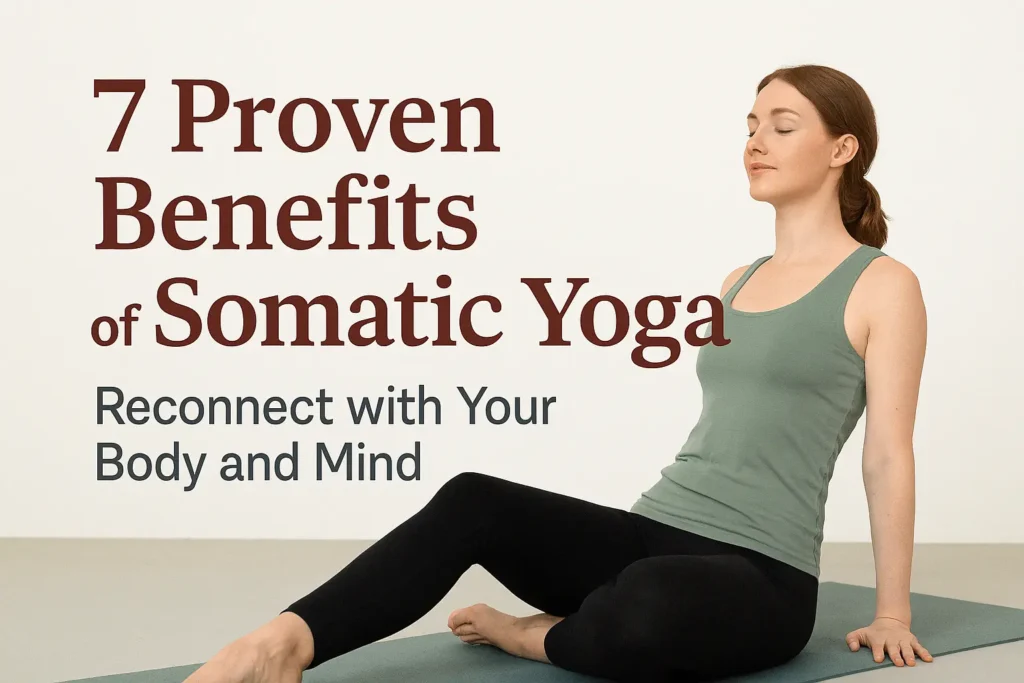
🧘♂️ What Is Somatic Yoga and Why It Matters
Somatic yoga is more than just a series of poses—it’s a quiet revolution happening inside your body.
At its core, somatic yoga is a gentle, mindful movement practice that helps you reconnect with your body from the inside out. Unlike traditional yoga styles that often focus on alignment or flexibility, somatic yoga invites you to slow down, feel, and listen.
It’s not about doing the pose “right.”
It’s about feeling what’s happening in your muscles, joints, and nervous system as you move.
🌿 The Meaning of “Somatic”
The word “somatic” comes from the Greek word “soma,” meaning “the living body in its wholeness.” Somatic yoga focuses on internal sensations (called interoception), spatial awareness (proprioception), and sensory input (exteroception).
These three awareness systems help you:
- Understand where your body is in space
- Tune into how it feels inside
- Identify unconscious tension or holding patterns
🧠 Sensory Motor Amnesia: The Hidden Cause of Discomfort
One of the foundational concepts in somatic yoga is Sensory Motor Amnesia (SMA)—a term coined by Thomas Hanna, the founder of Hanna Somatics.
SMA happens when your brain forgets how to fully activate or relax certain muscles, often due to chronic stress, trauma, or poor posture. As a result, your body gets stuck in a cycle of tension, pain, or imbalance—without you even realizing it.
Somatic yoga helps reverse this by re-educating your brain and body to move with ease again.
🔄 From Doing to Sensing
Instead of forcing your body into shapes, somatic yoga invites you to:
- Move slowly and consciously
- Notice sensations as they arise
- Pause, breathe, and observe
- Release what no longer serves you
This internal focus makes it especially helpful for:
- People with chronic pain
- Trauma survivors
- Those who feel “disconnected” from their bodies
You might not work up a sweat—but you’ll walk away feeling deeply relaxed, more centered, and truly in touch with yourself.
🔬 The Origins and Science Behind Somatic Yoga
Somatic yoga may seem like a modern wellness trend, but its roots run deep into the worlds of neuroscience, movement therapy, and mind-body medicine.
👨🏫 A Quick History: Where It All Began
The term “somatics” was popularized in the 1970s by Thomas Hanna, a philosopher and movement educator. He built upon the earlier work of Moshe Feldenkrais, founder of the Feldenkrais Method, which focuses on neuroplasticity through mindful movement.
Hanna introduced Hanna Somatic Education—a system that helps people regain voluntary control of muscles through slow, conscious movement. Somatic yoga applies similar principles within the framework of yoga, blending movement, mindfulness, and therapeutic awareness.
Other influential approaches that paved the way include:
- The Feldenkrais Method – Gentle movement to retrain the nervous system
- Alexander Technique – Releasing habitual tension to improve posture and function
- Body-Mind Centering – Embodied anatomy and movement exploration
Somatic yoga brings these influences together under a yoga lens—grounded, intuitive, and deeply healing.
🧠 The Science: Your Brain-Body Connection
Somatic yoga works directly with your central nervous system, helping it return to a state of balance.
Here’s how it works:
| Principle | What It Means | Why It Matters |
|---|---|---|
| Interoception | Awareness of internal sensations (heartbeat, breath, tension) | Helps you recognize stress and respond with care |
| Proprioception | Awareness of your body in space | Enhances balance and stability |
| Exteroception | Awareness of external touch or pressure | Grounds your body in the present moment |
| Neuroplasticity | Brain’s ability to rewire movement patterns | Allows for release of old tension and creation of healthier habits |
When you move slowly and consciously, your brain gets a chance to:
- Re-map faulty movement patterns
- Restore healthy communication with your muscles
- Turn off the “stress switch” (sympathetic nervous system)
- Turn on the “rest and repair” mode (parasympathetic nervous system)
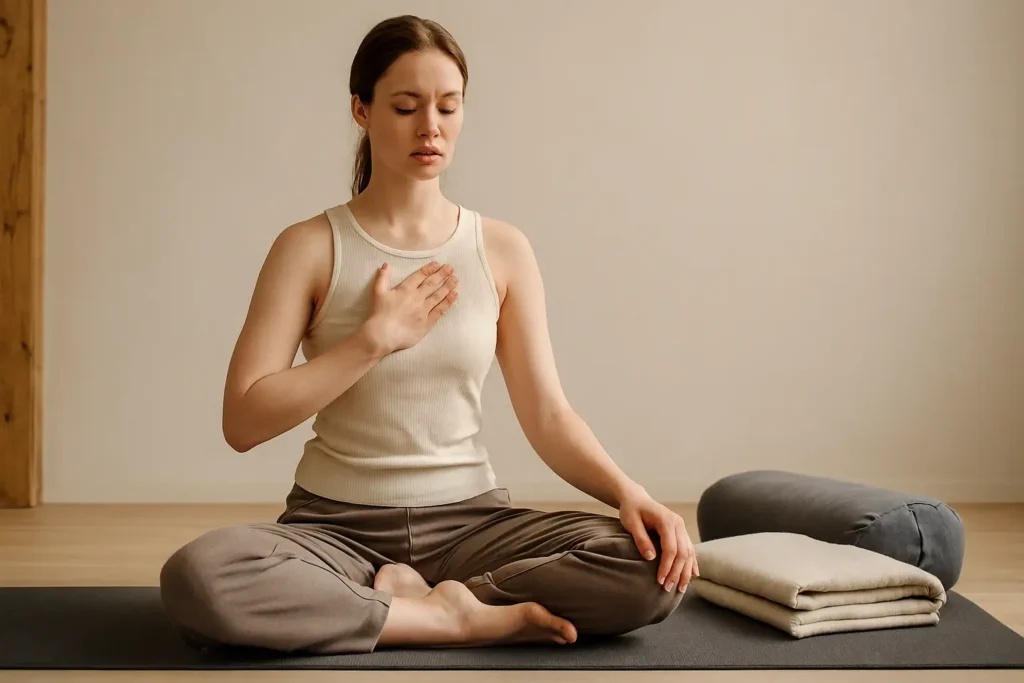
🧘♀️ Why This Matters for Healing
Whether you’re recovering from injury, dealing with trauma, or just tired of being stiff and tense, this approach gives you real tools to change how your body feels—from the inside out.
It also complements medical care and supports mental health by gently activating your body’s natural healing pathways.
✅ If you’ve ever wondered how your emotions, posture, and pain are connected, somatic yoga gives you the missing link.
🌟 7 Proven Benefits of Somatic Yoga
Somatic yoga isn’t just relaxing—it’s transformative. By tuning into your body’s internal signals and re-educating your nervous system, this practice unlocks physical, emotional, and even neurological benefits that can ripple through your entire life.
Let’s explore seven science-backed, beginner-friendly benefits of practicing somatic yoga regularly.
🧘♀️ 1. Relieves Chronic Stress and Anxiety
One of the most immediate effects people report is a deep sense of calm.
Somatic yoga activates the parasympathetic nervous system—your body’s natural “rest and digest” mode. This shifts you out of the fight-or-flight state, reducing cortisol (the stress hormone) and promoting relaxation.
How it helps:
- Slows heart rate and breathing
- Releases muscular tension in the neck, shoulders, and jaw
- Encourages a grounded, safe feeling in your own body
This is especially useful for people dealing with anxiety, burnout, or overwhelm. It’s like pressing a full-body reset button.
💓 2. Releases Stored Emotions and Trauma
Your body keeps score.
Chronic tension, especially in areas like the hips, lower back, and psoas muscle, often holds emotional residue—grief, fear, anger. Somatic yoga offers a safe container to access and release those held emotions through movement and breath.
Key signs this is happening:
- You yawn, cry, or sigh during or after practice
- A wave of emotion rises and passes without a clear reason
- You feel lighter afterward—emotionally and physically
This is one reason somatic yoga is often used in trauma-sensitive therapy and emotional healing practices.
⚡ 3. Reduces Chronic Pain
Chronic pain isn’t always about injury—it’s often about habitual tension and nervous system overdrive.
Somatic yoga works by rewiring neuromuscular pathways through slow, repetitive movements. This retrains your brain to let go of protective holding patterns, restoring pain-free mobility over time.
Common issues it can help relieve:
- Back pain
- Neck stiffness
- TMJ (jaw pain)
- Joint tension and tightness
👉 Want to explore other natural pain-relief techniques? Check out this 10-minute sciatic nerve relief method.
🧍♂️ 4. Improves Posture and Body Alignment
Poor posture isn’t just about slouching—it’s a result of unconscious muscular habits.
Somatic yoga helps you release Sensory Motor Amnesia (SMA)—a condition where your brain forgets how to fully relax certain muscles. As these muscles “wake up” and rebalance, your posture naturally improves.
Improvements you’ll notice:
- Shoulders drop and widen
- Spine elongates
- Head repositions in line with body
- Less strain in standing and sitting
Posture doesn’t have to be forced—it can feel effortless when your body remembers how to hold itself with ease.
🌀 5. Enhances Flexibility and Mobility
Unlike passive stretching, somatic yoga improves flexibility by re-educating your nervous system, not forcing your muscles.
By exploring movement from within, your muscles release tension gradually. This creates functional flexibility—the kind that supports real-life movements, not just yoga poses.
Great for:
- Beginners
- Seniors
- People recovering from injury
Flexibility becomes a natural byproduct, not the goal.
🧠 6. Increases Body Awareness (Interoception)
One of the most powerful effects of somatic yoga is how it helps you feel more present in your body.
This is called interoception—the awareness of internal sensations like heartbeat, breath, tension, hunger, or calm. It’s linked to better emotion regulation, improved self-trust, and reduced stress.
Daily benefits:
- Noticing tension before it becomes pain
- Responding to your body’s needs with kindness
- Feeling more embodied, grounded, and intuitive
This is where somatic yoga truly becomes a mindfulness practice.
💪 7. Supports Trauma Recovery and Nervous System Healing
If you’ve ever experienced trauma—emotional, physical, or both—your nervous system may be stuck in a constant state of hyper-alertness or shutdown.
Somatic yoga offers a safe, slow, and embodied practice that helps re-regulate the nervous system. Over time, this can:
- Reduce flashbacks or dissociation
- Restore a sense of control and safety
- Gently reconnect you with your body without overwhelm
🧠 Curious about how sleep and nervous system balance affect trauma and gut health? Read about acid reflux and sleep risks here.
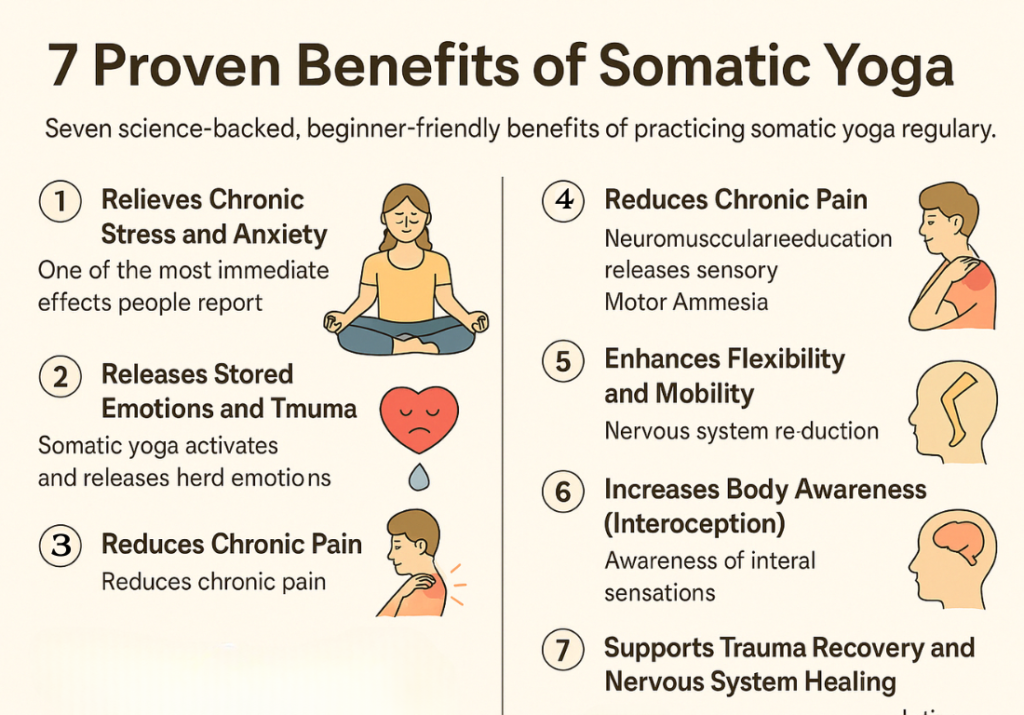
🧘 Beginner-Friendly Somatic Yoga Exercises
Somatic yoga doesn’t require flexibility or fancy gear. All you need is a quiet space, a soft surface (like a yoga mat or towel), and a willingness to slow down and feel.
These foundational movements can help you reawaken your body’s natural intelligence and start relieving tension right away.
🟢 1. Constructive Rest Pose
Great for grounding, breath awareness, and resetting the nervous system.
How to:
- Lie on your back with knees bent, feet flat on the floor hip-width apart
- Let your arms rest by your sides or across your belly
- Close your eyes and focus on the rise and fall of your breath
Internal Awareness:
- Notice how your spine makes contact with the floor
- Observe your breath in your belly and chest
- Sense where tension is held and where space feels open
🧘 Stay here for 5–10 minutes as your body naturally begins to unwind.
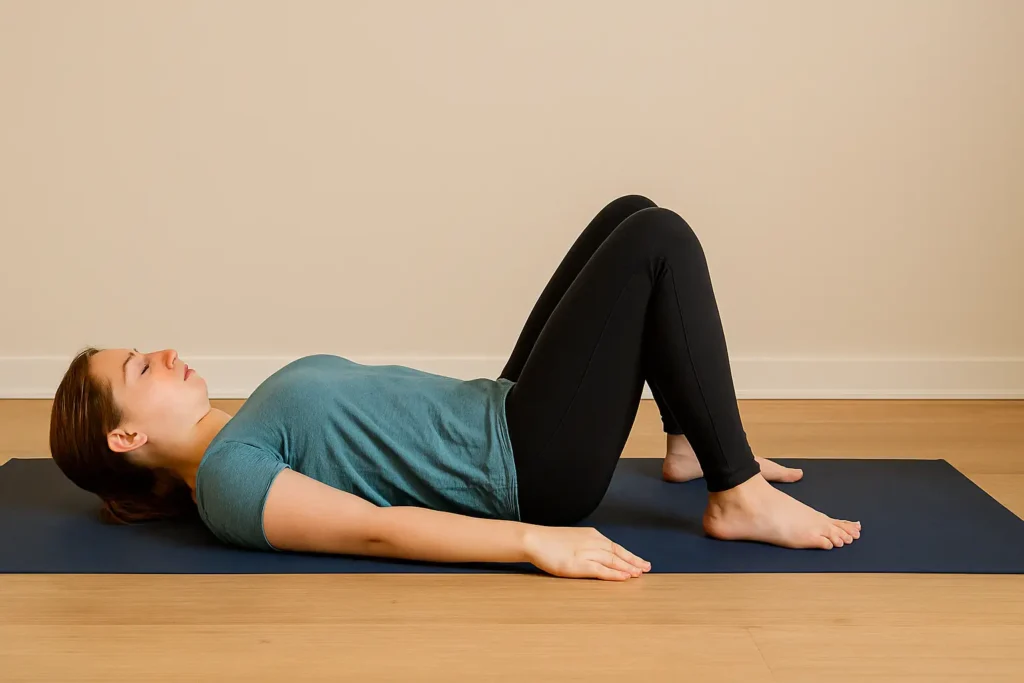
🔄 2. Cat-Cow with Breath Awareness
Improves spinal mobility and connects movement with breath.
How to:
- Come to hands and knees (tabletop position)
- Inhale: arch your back, lift your chest and tailbone (Cow)
- Exhale: round your spine, tuck chin and pelvis (Cat)
Internal Awareness:
- Feel each vertebra moving individually
- Match your breath to your movement
- Notice any stiffness, resistance, or ease in your spine
Do 6–8 slow rounds, pausing between each to check in with your body.
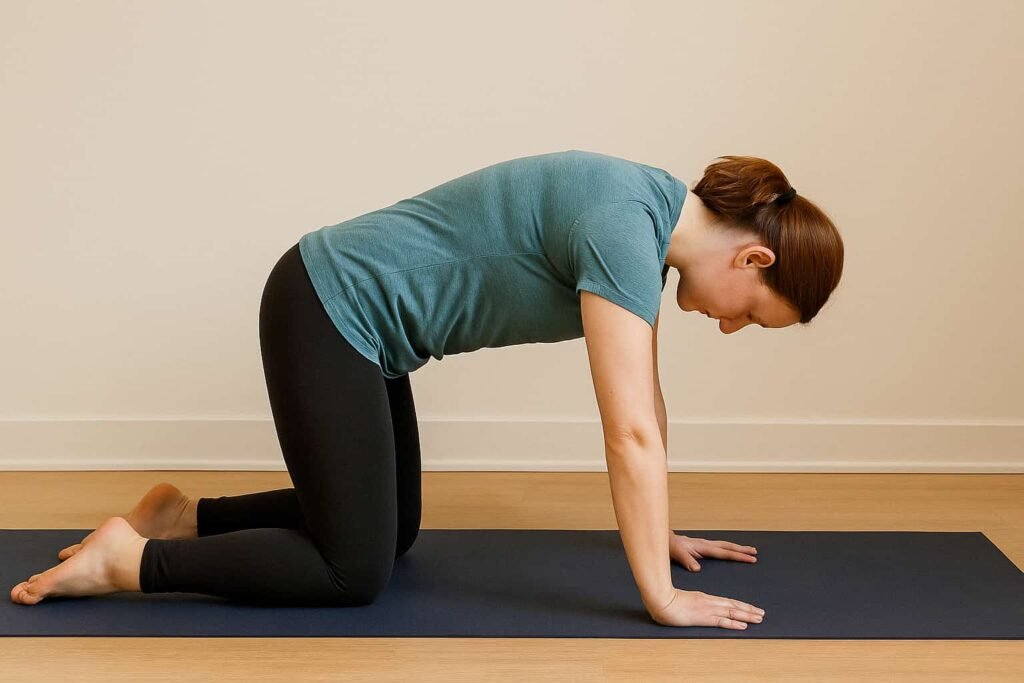
🌪️ 3. Reclined Knee Twist (Supine Twist)
Releases lower back tension and hydrates the spine.
How to:
- Lie on your back and draw knees toward your chest
- Drop both knees gently to one side while keeping shoulders grounded
- Extend arms in a T-shape or cactus position
Internal Awareness:
- Let gravity guide the twist—don’t force it
- Breathe into your ribcage, waist, and lower back
- Observe any emotion, tightness, or shift
Hold for 1–2 minutes per side with soft, steady breaths.
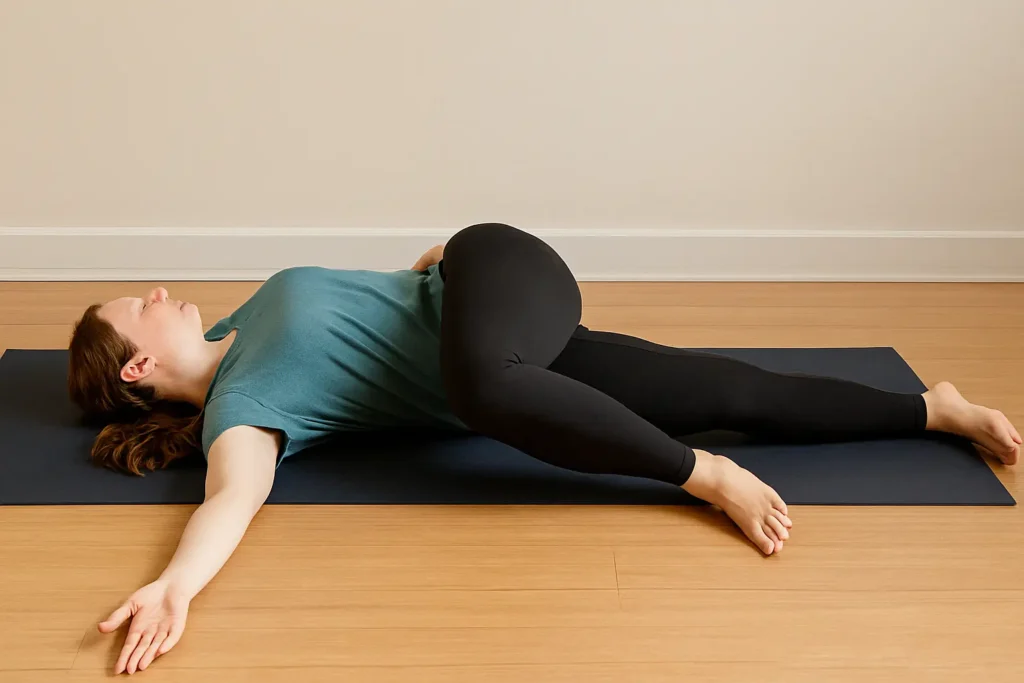
🌬️ 4. Three-Part Breath (Dirga Pranayama)
Deepens interoception and calms the nervous system.
How to:
- Sit or lie comfortably
- Inhale into the belly → then ribs → then upper chest
- Exhale in reverse: chest → ribs → belly
Internal Awareness:
- Feel the breath filling and emptying in stages
- Notice how your body moves with your breath
- Allow tension to melt on each exhale
Practice for 3–5 minutes daily, especially during times of stress.
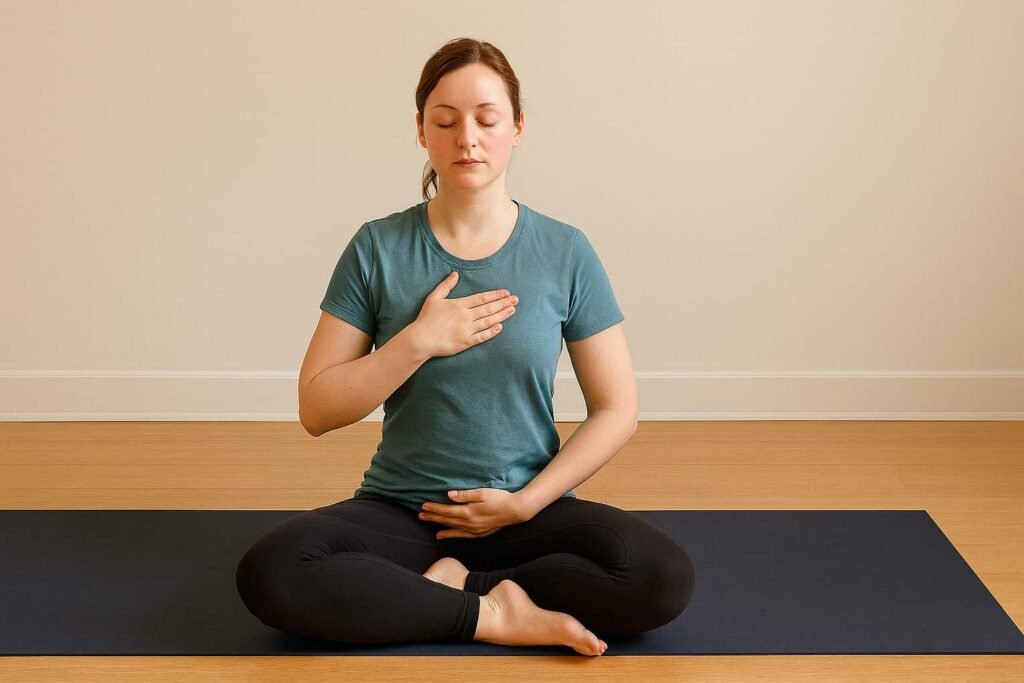
🧍 5. Bridge Pose (Pelvic Awareness Focus)
Improves pelvic mobility and reconnects brain-to-muscle coordination.
How to:
- Lie on your back with knees bent and feet flat
- Slowly lift your hips one vertebra at a time
- Inhale as you lift, exhale as you gently lower down
Internal Awareness:
- Pay attention to each part of the spine lifting and landing
- Engage and relax glutes and pelvic floor gently
- Feel the rhythm of movement from the inside
Repeat 5–8 times slowly—no rush, just breath-guided motion.
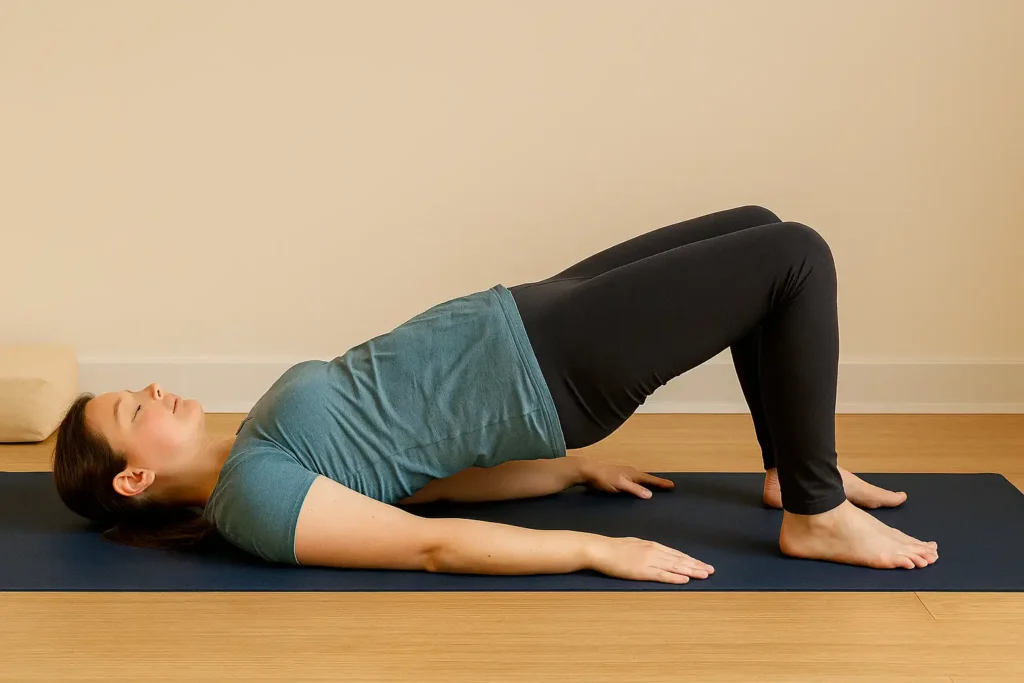
🌊 6. Wind Release Pose (Apanasana)
Gently massages abdominal organs and eases hip tightness.
How to:
- Lie on your back and hug one knee toward the chest
- Keep the other leg extended or bent
- Breathe deeply and hold for 30 seconds–1 minute per leg
Internal Awareness:
- Feel the pressure shift in your low belly and hips
- Breathe into any areas of compression or release
- Observe how the body reacts when you let go
This pose is also helpful for digestion and grounding.

🤲 7. Child’s Pose (Variation: Head on Arms)
Encourages introspection and surrender.
How to:
- Kneel with knees wide, big toes together
- Fold forward, rest your forehead on crossed arms or a block
- Allow your spine to lengthen and hips to settle
Internal Awareness:
- Let your breath gently press into the thighs and floor
- Observe where tension softens as you exhale
- Let go of effort and simply “be”
Stay here as long as it feels nourishing—especially at the end of a session.
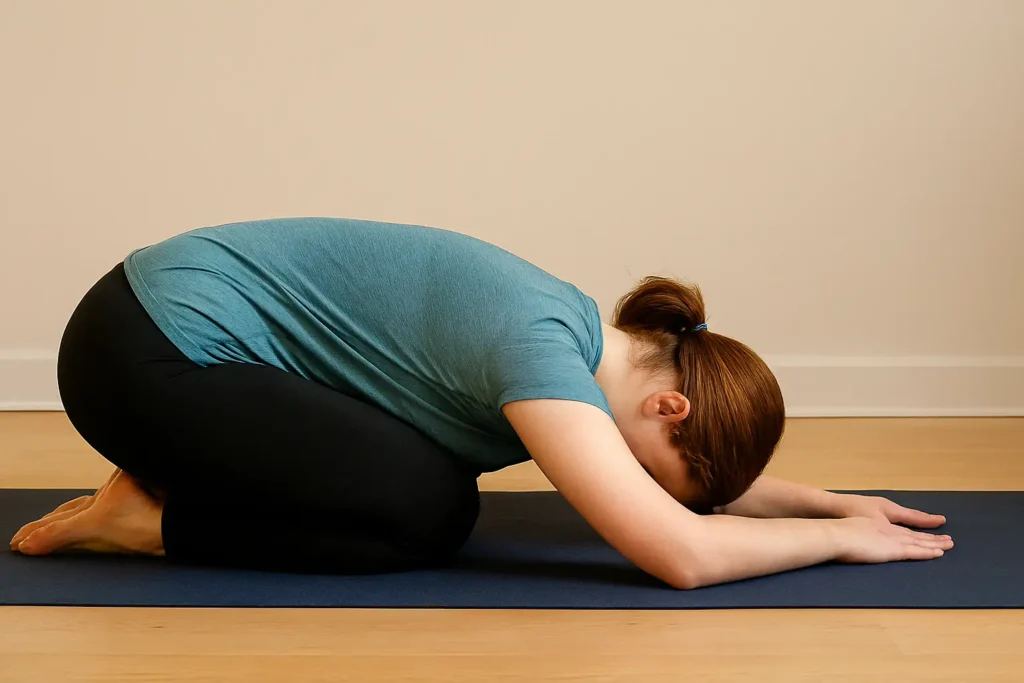
💡 Bonus: Micro-Practices for Everyday Moments
- Try a body scan while waiting in line
- Use Three-Part Breath before meals
- Do Cat-Cow first thing in the morning
- Add Constructive Rest before sleep
✅ How to Practice Somatic Yoga Safely
One of the best things about somatic yoga is that anyone can do it—regardless of age, experience, or physical limitations. But like any wellness practice, it’s important to approach it with care and self-awareness.
Here are key tips to ensure your journey into somatic yoga is safe, sustainable, and empowering.
🛑 1. Listen to Your Body, Always
Unlike fast-paced fitness routines, somatic yoga is inwardly guided. That means your body leads the way—not an instructor, video, or pose chart.
If it hurts—stop.
If something feels off—pause and breathe.
If it feels nourishing—stay with it.
💬 The goal is to feel more, not to “do more.”
🧘 2. Start Slow, Go Gentle
Somatic yoga is not about intensity. In fact, the slower you go, the deeper the benefits.
- Take your time with each movement
- Don’t rush through repetitions
- Pause and observe between poses
Gentle movement leads to deeper awareness.
🛋️ 3. Create a Safe, Quiet Space
Whether you’re practicing in a yoga studio or your living room, set the tone with a calm, quiet atmosphere.
You’ll need:
- A yoga mat or soft surface
- Comfortable clothing (nothing restrictive)
- Optional: pillow, bolster, or blanket for support
Silence or soft instrumental music can enhance your focus and presence.
📋 4. Consult Your Healthcare Provider (If Needed)
If you have:
- Recent injuries or surgeries
- Neurological conditions
- Chronic pain syndromes
- Or you’re pregnant
👉 Please check with your doctor or physical therapist before starting any new movement program.
Somatic yoga is therapeutic, but it’s not a substitute for medical care.
👥 5. Consider Working with a Somatic Yoga Instructor
While it’s absolutely beginner-friendly, you may benefit from:
- Guided audio/video sessions
- A certified somatic yoga teacher
- Therapeutic yoga specialists trained in trauma-sensitive care
Look for instructors familiar with Hanna Somatics, Feldenkrais, or trauma-informed yoga.
🙌 6. Let Go of Perfection
There’s no such thing as the “right” way to move in somatic yoga. If it helps:
- Close your eyes
- Let go of visual comparisons
- Focus entirely on sensation
Your experience is unique, and every session is an opportunity to learn more about yourself.
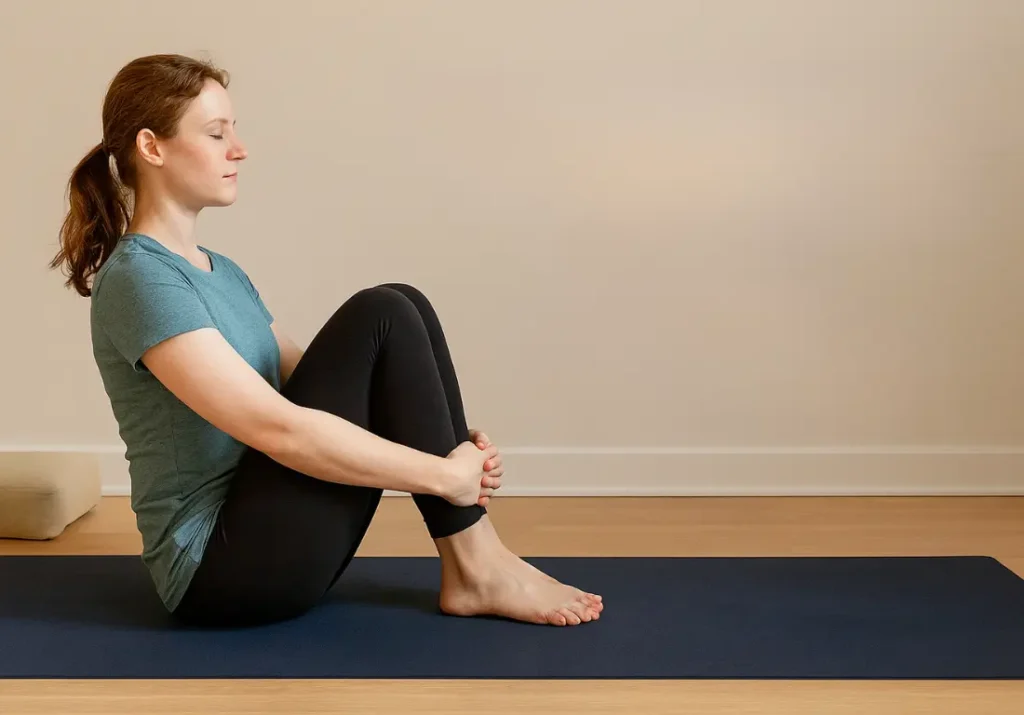
🌿 Integrating Somatic Awareness into Everyday Life
Somatic yoga isn’t just something you “do”—it’s a way of being in your body.
Once you begin tuning in during practice, you’ll naturally start to notice how your body feels throughout your day. These small awareness shifts can lead to less stress, better posture, and more ease—without setting foot on a mat.
Here’s how to bring somatic principles into daily life in simple, meaningful ways.
👂 1. Practice Micro Body Scans
Set a reminder (on your phone or by habit) to do a 30-second check-in throughout the day.
Ask yourself:
- Where am I holding tension right now?
- Am I breathing freely?
- Do I feel grounded, slouched, or tight?
Then:
- Exhale slowly
- Unclench your jaw, soften your shoulders
- Adjust your posture with awareness
These 30-second check-ins create huge long-term shifts in body awareness.
💨 2. Use Mindful Breathing During Stress
Somatic yoga teaches you that breath is your anchor. You can use this anywhere—traffic, meetings, parenting moments.
Try this:
- Inhale slowly through your nose
- Exhale even more slowly through your mouth
- Repeat 3–5 times while noticing how your belly and chest move
This helps downshift your nervous system on the spot.
🪑 3. Bring Somatic Movement to Your Desk
Sitting all day doesn’t have to mean stiffness and fatigue. Bring movement into your sedentary moments.
Try this simple seated somatic release:
- Gently circle your shoulders
- Do small spinal rolls (head to tail)
- Roll your pelvis forward/backward
- Close your eyes and feel each motion slowly
Just 2–3 minutes every hour can ease tension and improve focus.
🍽️ 4. Use Somatic Awareness While Eating
Yes—somatic yoga principles even apply to meals!
Practice mindful eating by:
- Slowing down your pace
- Chewing thoroughly
- Noticing the sensations of hunger and fullness
- Paying attention to taste, texture, and smell
This can also help manage emotional eating and improve digestion.
😌 5. Pause Before Reacting
Somatic awareness also helps with emotional regulation. The next time you feel triggered or anxious:
- Pause and scan your body
- Notice tension, heat, or shallow breath
- Respond with a small movement: a shoulder roll, a sigh, or walking slowly
Small, conscious shifts can change your nervous system’s response to stress.
🧘 Bonus Tip: End Your Day with Constructive Rest
Right before bed, try 5–10 minutes of Constructive Rest Pose to:
- Release the day’s tension
- Slow your breathing
- Signal to your body that it’s time to unwind
This is especially helpful if you deal with sleep disruption or nighttime discomfort—read more about acid reflux and sleep risks here.
🎯 Expert Tips to Maximize Your Somatic Yoga Results
Whether you’re just beginning or already feeling the benefits, these simple, powerful suggestions can help you make somatic yoga a sustainable and transformative part of your life.
These insights are rooted in the teachings of pioneers like Thomas Hanna, Moshe Feldenkrais, and modern somatic yoga therapists.
🧘 1. Make Consistency Your Priority—Not Duration
You don’t need to practice for an hour a day.
In fact, 10 minutes daily is often more effective than one long session per week.
Try this:
- Start with one or two poses
- Set a timer for 5–15 minutes
- Focus on slow, mindful movement—not “working out”
Consistency rewires your nervous system gently and effectively.
✍️ 2. Journal After Practice
Somatic yoga stirs both physical and emotional layers. Writing down your sensations, emotions, or insights after practice helps integrate what your body is teaching you.
Use prompts like:
- What did I notice today?
- Where did I feel tension or ease?
- What surprised me?
This reflection deepens self-awareness and reinforces learning.
🎧 3. Use Guided Somatic Audio or Video Sessions
Especially in the beginning, it helps to be led through the process. Look for:
- Certified somatic yoga instructors
- Trauma-informed facilitators
- Gentle, beginner-friendly formats
YouTube channels, online courses, and audio meditations can provide structure and safety while you learn.
✅ Tip: Avoid overly performance-based yoga content—somatic yoga is about feeling, not achieving.
🛑 4. Skip Poses That Don’t Feel Right (Even If They’re “Beginner”)
One of the most empowering aspects of somatic yoga is giving yourself permission to skip what doesn’t serve you.
- Your body knows more than the script
- Modify or skip any movement that causes discomfort
- Focus on where sensation and breath flow freely
Practicing with compassion, not force, leads to real progress.
📚 5. Learn About the Nervous System
Understanding why somatic yoga works can inspire more trust in the process. Read about:
- The vagus nerve
- Fight/flight vs. rest/digest
- Sensory Motor Amnesia
- Neuroplasticity
This gives context for your journey and affirms the real, biological shifts that happen through gentle movement.
🌕 6. Practice in Sync with Your Body’s Energy Rhythms
Morning: Great for energizing, grounding movement like Cat-Cow or Bridge
Evening: Ideal for calming practices like Child’s Pose or Constructive Rest
Stressful Day: Try Three-Part Breath or Body Scan anytime
Matching your practice to your energy makes it more sustainable—and enjoyable.
💡 7. Celebrate the Subtle Wins
You might not break a sweat.
You might not feel “accomplished” in the traditional sense.
But somatic yoga isn’t about metrics. It’s about:
- Noticing tension that wasn’t there yesterday
- Feeling safe in your own skin
- Breathing a little deeper
- Sleeping a little better
These small shifts are the healing.
🚫 Common Myths and Misunderstandings About Somatic Yoga
Because somatic yoga is so different from traditional yoga styles or fitness routines, it’s often misunderstood—even by experienced yogis. Let’s clear the air and debunk some myths that might hold people back from its full benefits.
❌ Myth 1: “Somatic yoga is just stretching.”
✅ Truth: While some poses look like stretching, somatic yoga is about retraining the nervous system, not lengthening muscles.
Instead of pushing into a stretch, you move slowly to teach your brain how to release unconscious tension and restore natural mobility.
Stretching focuses on muscles. Somatic yoga focuses on movement patterns and awareness.
❌ Myth 2: “It’s too slow to be effective.”
✅ Truth: Slowness is the whole point—and it’s exactly what makes it powerful.
By moving slowly, you give your brain time to notice, adjust, and heal. Fast movement reinforces old patterns. Slow movement creates new ones.
Think of it as neural rewiring, not a workout. You’re not burning calories—you’re changing your relationship with your body.
❌ Myth 3: “You have to be flexible or fit to try it.”
✅ Truth: Somatic yoga is designed for every body—regardless of size, shape, ability, age, or experience.
Most practices are done lying down or seated, and every movement can be adapted or modified.
In fact, it’s ideal for:
- Seniors
- People with chronic pain
- Desk workers
- Trauma survivors
- Absolute beginners
❌ Myth 4: “It’s the same as gentle yoga or yin yoga.”
✅ Truth: While all three are slow and calming, somatic yoga is more about internal experience than external posture.
- Yin yoga focuses on deep tissue stretch
- Gentle yoga is a slower version of traditional flow
- Somatic yoga focuses on nervous system re-patterning, interoception, and movement awareness
It’s more like body-based mindfulness therapy than traditional yoga.
❌ Myth 5: “It’s only for trauma or healing.”
✅ Truth: While somatic yoga is incredibly effective for emotional healing and trauma recovery, it’s also:
- Great for stress management
- Supportive for athletic recovery
- Ideal for people with posture issues
- A powerful tool for preventative care
Anyone who wants to feel more connected, present, and pain-free can benefit.
🧘♀️ Final Thoughts and Free Yoga Resource
If you’ve ever felt disconnected from your body, overwhelmed by stress, or frustrated by chronic pain, somatic yoga offers a gentle way back to yourself.
This isn’t just another form of exercise—it’s a practice of listening, healing, and relearning how to feel at home in your own skin.
You don’t need to be flexible.
You don’t need experience.
You just need a quiet space and a few minutes of awareness.
Whether you’re easing into movement after injury, supporting your nervous system, or simply seeking a deeper kind of self-care, somatic yoga can meet you exactly where you are—and take you where you want to go.
🎁 Get Your Free Somatic Yoga Starter Guide
Ready to start your journey with ease and confidence?
👉 [Download your FREE Somatic Yoga for Beginners Guide here] (insert downloadable link)
It includes:
- A printable daily routine
- Simple pose breakdowns
- Breathwork cues
- Self-check journaling prompts
💌 Stay Connected
Want more body-mind healing practices, natural wellness tips, and free guides?
👉 Sign up for updates from FitLifeAce and join a supportive community that’s learning to move, breathe, and live with more awareness—one day at a time.
Thank you for joining me in exploring the powerful, restorative world of somatic yoga. May your practice be gentle, your awareness deep, and your journey healing.
❓ FAQs
What is somatic yoga, and how does it work?
Somatic yoga is a gentle, mindful movement practice that helps you reconnect with your body through breath, awareness, and slow, intentional motion. It retrains your nervous system to release chronic tension and supports emotional healing.
Is somatic yoga good for beginners?
Yes—somatic yoga is ideal for beginners. It’s slow, adaptable, and focuses on how your body feels, not how it looks. No experience, flexibility, or fancy poses are needed.
Can somatic yoga help with trauma?
Somatic yoga supports trauma release by calming the nervous system and gently unlocking stored tension in the body. While not a replacement for therapy, it complements trauma-informed care.
What’s the difference between somatic yoga and restorative yoga?
Restorative yoga focuses on stillness and relaxation through passive poses, while somatic yoga involves gentle, mindful movement to rewire the nervous system. Both are healing, but serve different purposes.
Can somatic yoga help with chronic pain or injury recovery?
Yes, somatic yoga is often used for conditions like back pain, joint stiffness, fibromyalgia, and post-trauma recovery. Always check with your doctor before starting any new movement practice.
How often should I do somatic yoga to see results?
Practicing 2–5 times per week—even for just 10–15 minutes—can improve body awareness, reduce stress, and ease chronic tension. Consistency matters more than intensity.
Does somatic yoga promote weight loss?
Somatic yoga isn’t a weight-loss workout, but it may indirectly support healthy weight by lowering stress, improving sleep, and promoting mindful eating habits.
Is somatic yoga scientifically backed?
Yes. Somatic yoga is grounded in neuroscience and trauma research. It supports neuroplasticity, vagus nerve regulation, and helps reverse sensory motor amnesia linked to chronic pain.
Can I do somatic yoga if I’m not flexible?
Absolutely. Flexibility isn’t required. Somatic yoga is about internal awareness, not achieving extreme poses. It meets your body exactly where it is.
Do I need equipment or props for somatic yoga?
All you need is a yoga mat or soft surface and comfortable clothing. A cushion or blanket is optional for extra support, but not essential.
Can somatic yoga improve sleep?
Yes—many people use somatic yoga at night to relax the body and calm the mind. Simple breathing exercises and slow movements help ease into restful sleep.
What types of sensations should I notice during practice?
You might feel warmth, tingling, tightness releasing, or even subtle emotional shifts. These are signs your nervous system is recalibrating and letting go.
Is it normal not to feel anything during somatic yoga?
Yes, especially at first. Developing body awareness takes time. With consistent practice, your sensitivity to internal sensations will naturally grow.
Can somatic yoga be done at home without a teacher?
Yes. Somatic yoga is beginner-friendly and can be done at home with guided videos or written instructions. Listening to your body is the most important guide.
Is somatic yoga helpful for anxiety or burnout?
Somatic yoga activates the parasympathetic nervous system, which helps reduce anxiety, improve mood, and relieve physical symptoms of burnout.
How is somatic yoga different from regular yoga?
Traditional yoga often emphasizes form and flexibility, while somatic yoga focuses on how movement feels inside your body. It’s about sensation over shape.
Who should avoid somatic yoga?
Most people can safely practice somatic yoga. However, those with acute injuries, recent surgeries, or trauma-related conditions should consult a healthcare provider or trauma-informed teacher first.

